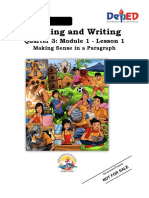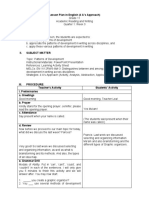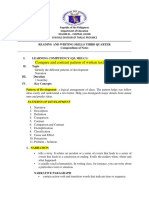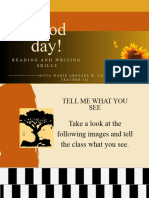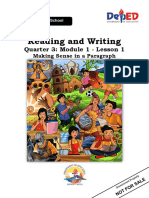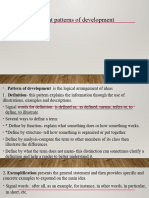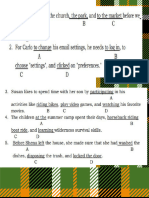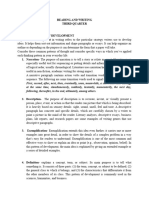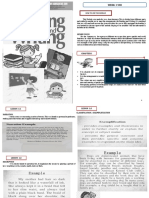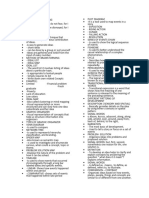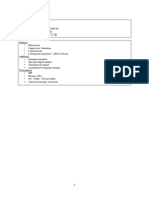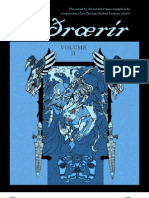LESSON 1
PATTERN OF DEVELOPMENT IN WRITTEN TEXT
PATTERNS OF DEVELOPMENT IN WRITTEN TEXTS
• A pattern of development in writing refers to the particular strategy writers use to
develop ideas. It is the logical arrangement of ideas in a text.
• The pattern helps you follow ideas easily and understand a text better. Moreover,
knowing that these common patterns of human thought exist, will help you to both
develop and organize information in your essays or compositions.
• The pattern of paragraph development presents ideas in logical and consistent
structure to manage information in an essay. Thus, the logical organization of
paragraphs greatly enhances the ease with which one can understand and
remember the information presented. People seek out patterns to help make sense
of information. When a reader is not able to find a pattern that makes sense, chaos
and confusion abound.
PATTERNS OF DEVELOPMENT IN WRITTEN TEXTS
• Narration • Description • Definition • Classification / Exemplification
• Comparison and Contrast • Cause and Effect • Problem Solution
• Persuasion
1
� 1. Narration- It is the most basic pattern of development. It describes how,
when and where an event or occurrence happened. Likewise, it is used to tell
a story or focus on a set of related events.,
Example:
It was July 21, 1969, and Neil Armstrong awoke with a start. It was the day he would
become the first human being to ever walk on the moon. The journey had begun
several days earlier, when July 16th, the Apollo 11 launch from Earth headed into
outer space. On board with Neil Armstrong were Michael Collins and Buzz Aldrin.
The crew landed on the moon in the Sea of Tranquility a day before the actual walk.
Upon Neil’s first step onto the moon’s surface, he declared. “That’s one small step
for man, one giant leap for mankind.” It sure was!
2. Description-The pattern of development which goes into details about a
specific object, person, or location, in order to firmly set its appearance
Example:
Sunset is the time of day when our sky meets the outer space solar winds. There
are blue, pink, and purple swirls, spinning and twisting, like clouds of balloons
caught in a blender. The sun moves slowly to hide behind the line of horizon, while
the moon races to take its place in prominence atop the night sky. People slow to
crawl, entranced, fully forgetting the deeds that still must be done. There is
coolness, a calmness, when the sun does set.
3. Definition- It explains not just what something means or is, but also what
something is used for.
2
�Example:
Déjà vu is a French word meaning “already seen”. It has also been described as a
feeling or experience that one has seen something before. For example, you are
waiting in line to check out the grocery store and the lady behind you asks you to
hand her a pack of gum. Suddenly you get an overwhelming feeling that you have
been there in the exact same spot, talking to the same lady, even the same brand
gum. Even though everything seems so familiar you know there is no way that
could have happened before. There are many theories as to why and how this
phenomenon happens. One theory is that déjà vu is connected with temporal-lobe
epilepsy, but people without a history of epilepsy have also experienced déjà vu.
Psychiatrists believe it is something in your brain that confuses an event that
happened in the past with the present. Another theory is parapsychologist think it
is connected with past life experiences. Whether déjà vu is an experience of the
paranormal or simply some confusion in the brain, it a perplexing feeling of having
“already seen.”
4. Classification- A classification pattern organizes ideas into categories or
divisions based on criteria and standards. This pattern can be used when
classifying people, objects, events, things, places, and other items.
Example:
There are three kinds of book owners. The first has all the standard sets and best
sellers – unread, untouched (this deluded individual owns wood pulp and ink, not
books). The second has many great books – a few of them read through, most of
them dipped into, but all of them read as clean and shiny as the day they were
bought (this person would probably like to make books his own, but is restrained
by a false respect of their physical appearance). The third has a few books or many
– every one of them dog-eared and dilapidated, shaken and loosened by continual
3
�use, marked and scribbled in from front to back (this man owns his books). In which
classification would you belong?
5. Comparison-Contrast- This pattern organizes ideas based on how events,
places, people, things and concepts are similar to or different from one
another.
Example:
Oceans and lakes have much in common, but they are quite different. Both are
bodies of water, but ocean are very large bodies of salt water, while lakes are much
smaller bodies of fresh water. Lakes are usually surrounded by land, while oceans
are what surround continents. Both have plants and animals living in them. The
ocean is home to the largest animals on the planet, whereas lakes support much
smaller forms of life. When it is time for vacation, both will make a great place to
visit and enjoy.
6. Cause and Effect- This pattern explains why something happens or what
results a particular event produces. It organizes details based on the causes,
the reason, and the result or consequences of certain phenomenon.
Example:
I do well in school, and people think I am smart because of it. But it’s not true. In
fact, three years ago I struggled in school. However, two years ago I decided to get
serious about school and made a few changes. First, I decided I would become
interested in whatever was being taught, regardless of what other people thought. I
also decided I would work hard every day and never give up on any assignment. I
decided to never, never fall behind. Finally, I decided to make school a priority over
friend and fun. After implementing these changes, I became an active participant in
4
�classroom discussions. Then, my test scores began to rise. I still remember the first
time that someone made fun of me because I was smart. How exciting! It seems to
me that being smart is simply a matter of working hard and being interested.
Unfortunately, learning a new video game doesn’t help you get into college or get a
good job.
7. Problem Solution- This pattern organizes ideas into problems and proposed
solutions. The problem section usually includes the what, who, when, why
and how of the problem. The other part then presents the major effects of
the problem and the possible solutions to address it, as well as the steps in
implementing the solution.
Example:
Last week we installed a kitty door so that out cat come and go as she pleases.
Unfortunately, that ran into a problem. Our cat was afraid to use the kitty door. We
tried pushing her through, and that caused her to be even more afraid. The kitty
door was dark, and she couldn’t see what was on the other side. The first step we
took in solving this problem was taping the kitty door open. After a couple of days,
she was confidently coming and going through the open door. However, when we
removed the tape and closed the door, once again, she would not go through. They
say you catch more bees with honey, so we decided to use food as bait. We would
sit next to the kitty door with a can of wet food and click the top of the can. When
kitty came through the closed door, we would open the can and feed her. It took
five days of doing this to make her unafraid of using the kitty door. Now we have
just one last problem, our kitty controls our lives!
8. Persuasion- Persuasion pattern organizes ideas to show how a set of
evidence lead to a logical conclusion or argument. Specifically, this pattern
5
� presents the issue, the position, and the supporting evidence that supports
the position.
Example:
Last year was the first time I had ever been the new kid at school. For the first four
days, I was completely alone. I don’t think I even spoke to a single person. Finally, at
lunch on the fifth day, Karen Watson walked past her usual table and sat down right
next to me. Even though I was new, I had already figured out who Karen Watson
was. She was popular. Pretty soon, all Karen’s friends were sitting there right next
to me. I never became great friend with Karen, but after lunch that day, It seemed
like all sorts of people were happy to be my friend. You cannot convince me that
Karen did not know what she was doing. I have a great a great respect for her, and I
learned a great deal about what it means to be a true leader.
6
�LESSON 2
PROPERTIES OF A WRITTEN TEXT
PROPERTIES OF A WRITTEN TEXT
● ORGANIZATION
● COHERENCE AND COHESION
● LANGUAGE USE
● MECHANICS
TEXT ORGANIZATION
• Text organization is the way a text is organized that helps to guide the reader
logically through it. This property makes a text readable and clear. In simpler words,
it is the consistent development and completeness of ideas in a text.
• You have to remember that a well-organized piece of writing supports readers by
making it easy for them to follow.
7
� How can text organization be achieved?
WHAT ARE THE TECHNIQUES TO ACHIEVE TEXT ORGANIZATION?
1. PHYSICAL FORMAT
- it is an aspect of the organization that is immediately apparent to the reader. It is
seen in how the text physically appears like headings and subheadings, bullet
points or font emphasis. However, use this technique with discretion as improper
or superfluous formatting can be confusing.
Example:
• Marxist ideology has three main theories. Historical materialism claims that all the
features of society can historically be traced back to economic activity. Social class
in capitalist societies is what produces unjust structures of power that exist today.
Socialism would be the next rational step for the development of human society.
8
�Explanation:
• The words in bold are the three main most important Marxist theories that the
first sentence is referring to. By emphasizing these words, the reader can identify
the correct term for the concepts along with their definitions; this would also aid in
remembering the theories since they stick out from the rest of the text.
2. SIGNAL WORDS
- are textual cues that readers can use to follow a text. They can "signal" the
transition from one point to another, the ordering of events and concepts, or the
writer’s chosen text type (e.g., linear narration, question and answer).
Example:
Chuck Palahniuk’s novel Fight Club greatly influenced me as a fictional writer. First,
his use of the unreliable narrator fascinated me, and I have written similar
characters in my works. Second, the theme of patriarchal oppression can also be
found in the stories I write. Third, the novel’s stunning twist is something that I have
been trying to recreate. Thus, I am extremely grateful to have encountered
Palahniuk’s genius early in my writing career.
Explanation:
By using sequential signal words (first, second and third) before the beginning of
every sentence, the reader can follow what seems to be the writer’s list of three
reasons why the novel influenced him. The word “thus” also signals the conclusion
and the end of the list, out from the rest of the text.
3. STRUCTURE
- provides the framework upon which the text is organized. It consists of the
following:
• Beginning: introduction, thesis statement, hook
• Middle: supporting details
• End: conclusion, summary, final message
9
�Example:
Ancient philosophies believe that a person has an "aura," this appears as a rainbow
of light around the body that can be seen by individuals with clairvoyant abilities.
The colors change depending on one's mood, health and thoughts. Some scientists
believe that the existence of the aura has something to do with the electromagnetic
fields produced by cells and tissues in the human body. Whether auras are real or
not, the fact remains that there are forces everywhere that are real even though we
cannot see them,
Explanation:
Organization in this paragraph is not readily noticeable as it does not use cues like
formatting or signal words. However, the text is organized in this way:
• Beginning: Introduce topic of aura
• Middle: Definition and evidence of existence of auras
• End: Ending message about forces in the world
By adhering to the structure, the writer can produce a text that is still easy to
follow. The topic, supporting details and concluding message is still clear to the
reader.
What is Coherence?
- it is the connection of ideas at the idea level
- "rhetorical" aspects of writing which include developing and supporting
arguments (e.g. thesis statement development, synthesizing and integrating
readings, organizing and clarifying ideas)
- it is the overall sense of unity in a passage including both the main point of
sentences and the main point of each paragraph
10
�What is Cohesion?
- it is the connection of ideas at the sentence level
- it focuses on the "grammatical" aspects of writing
GOOD COHESION IS ACHIEVED THROUGH THE FOLLOWING FIVE MAIN
METHODS:
1. Repeated words/ideas
2. Reference words
3. Transitional Signals
4. Synonyms
5. Parallelism
1. Repeated words/ideas - one way to achieve cohesion is to repeat words, or
to repeat ideas using different words.
Example: Most students are intimidated by the works of William Shakespeare. They
believe Shakespeare's sonnets and plays are far too complicated to read and
understand.
2. Reference words - are words which are used to refer to something which is
mentioned elsewhere in the text, usually in a preceding sentence. The most
common type is pronoun.
Example: Mr. Thompson agreed to meet with members of the worker’s union
before he signed the contract. He was interested in hearing their concerns about
the new insurance plan.
3. Transitional Signals - are also called cohesive devices or linking words.
These are words or phrases which show the relationship between ideas.
Some examples of transitional signals are:
11
�a. Time – first, immediately, afterward, before, at the same time, after, earlier,
simultaneously, finally, next, in the meantime, later, eventually, then, meanwhile,
now, subsequent, etc.
b. Sequence – moreover, furthermore, next, also, finally, last, another, first, second,
third, besides, additionally, etc.
c. Space – above, next to, below, behind, beside, etc.
d. Illustration – for instance, specifically, for example, namely, in this case, to
illustrate, etc.
e. Comparison – similarly, also, in the same way, still, likewise, in comparison, too,
etc.
f. Contrast – but, despite, however, even though, yet, on the other hand, although,
on the contrary, otherwise, conversely, nevertheless, instead, in spite of; etc.
g. Cause and effect – because, as a result, consequently, then, so, since, etc.
h. Conclusion – thus, therefore, in conclusion, in short, etc.
4. Transitional Signals – are also called cohesive devices or linking words.
These are words or phrases which show the relationship between ideas.
Some examples of transitional signals are:
Example: Many students believe they cannot write a good essay because they are
not writers. However, as they practice writing and work on developing their writing
skills, most students are able to gain the needed confidence to start thinking of
themselves as writers.
5. Synonyms – are words that have the same or nearly the same meaning as
another word. They provide alternative word choices that can add variety to
a text and can help eliminate unnecessary repetition.
12
�Example: Teenagers face an enormous amount of peer pressure from friends and
schoolmates. As a result, many young adults are exhibiting signs of severe stress or
depression at an early age.
6. Parallelism – is the use of matching words, phrases, clauses or sentence
structures to express similar ideas. Parallel structures allow the reader to
flow smoothly from one idea, sentence or paragraph to the next and to
understand the relationships and connections between ideas.
Example: Usually, the children spend the summer weekends playing ball in park,
swimming in the neighbor’s pool, eating ice cream under the three, or camping in
the backyard.
Below are examples of paragraph with poor and strong cohesion. Have a closer
look on how they differ.
13
�Coherence involves..
How do you check whether you achieve coherence?
- Analyze the essay paragraph by paragraph.
- Do the paragraph breaks come in natural places?
- Does every paragraph focus only on one aspect of the problem?
- Read the paper from beginning until the end without any pauses.
- Does it give you a sense of completeness and unity?
14
�- Think about your impressions.
- Can you tell straight away what the main idea of the text is after you have read it?
- It is clear what opinion the author sticks with?
Below are examples of paragraph with poor and strong coherence. Have a
closer look on how they differ.
LANGUAGE USE?
• Language use is one of the clearest indicators of a well-written text. It enables
writers to effectively communicate ideas without confusing the reader. It allows the
writer to express the message that they want to convey to the readers.
LEVELS OF LANGUAGE USE
1. Informal/Personal
2. Standard/Academic
15
� 3. Business/Technical
LEVELS OF LANGUAGE USE
● Informal/Personal - slang, local expressions, text messaging. It is usually
used in writing for family, friends, and colleagues
Examples:
a. Hey
b. Sup
c. OTW
d. BRB
e. Bes
f. Pet (friend)
● Standard/Academic - widely accepted words and phrases found in books,
magazines, and newspapers.
Examples: Note to a professor:
I missed the class last night. May I e-mail my paper later? The problem is garbage
management as it greatly affects the students who are occupying the SJH Bldg.
● Business/Technical - scientific terms, jargons, and special expressions.
Examples:
Psychiatrist’s Report:
“Dissociative rage order is not indicated by the ER assessment.”
Education:
16
�“This School Year, the Department of Education focused only on the Most Essential
Learning Competencies (MELC).”
PRINCIPLES OF LANGUAGE USE
1. Use clear and concise sentences, usually about 18 words long.
2. Avoid redundancies, clichés, wordiness, and highfalutin.
○ Don’t judge a book by its cover.
○ When pigs fly.
○ Happily eve after
○ Easy as a pie
PRINCIPLES OF LANGUAGE USE
Avoid redundancies, clichés, wordiness, and highfalutin
Wordiness Wordy Simplified
is located in is in
17
� is required to must or should
look into consider
Highfalutin words
● Hackslaver - to hesitate or stammer in speech • Hedley-medley - a
confused jumble
3. Although may be used, avoid overusing, “There” and “It”. Drop it.
There’s a book on the table. A book is on the table
4. Use precise vocabulary. Be accurate. Be condensed.
We’re going to make a country in We hope to build an inclusive
which no one is left out. society
5. Be consistent in pronoun point of view
| We should simply accept that fate | We should simply accept that fate
is simply an illusion; you must not is simply an illusion; we must not
leave our decisions something that leave our decisions something that
does not exist. does not exist.
6. Avoid Sexist language
Every employee should submit his Every employee should submit their
credentials credentials
7. Use appropriate level of formality
Yes, diskettes are like a thing of the Diskettes may be outdated, but they
past but they’re still cool today. are still fascinating.
18
� LANGUAGE'S LEVEL OF FORMALITY
TONES OF WRITING COVERED BY LANGUAGE USE?
1. Subjective Tone - uses the writer’s personal biases and judgement. It
tells us something about the writer, and particularly on how he/she
feels.
Example: Here is an excerpt from the Ode on a Grecian Urn by John Keats
“Heard melodies are sweet, but those unheard
19
� Are sweeter; therefore, ye soft pipes, play on… Pipe to the spirit ditties of no
tone:
Fair youth, beneath the trees, thou canst not leave Thy song, nor ever can
those trees be bare;”
Explanation:
This is an example of a subjective approach. Here, the speaker expresses his
feelings of love for the old days of Ancient Greece. In this stanza, he is talking
about a musician who is playing pipes beautifully. He escapes from physical
world to his world of fantasy, where weather never changes and there is an
eternal spring. The act of the writer of expressing his own feeling makes this
example a subjective writing.
2. Objective Tone - uses factual information and arguments. It is an
impersonal style of writing. It gives us information about something
but does not include information about the writer.
Example: Here is a portion of the news on "Ministry of Health prepares Lao media
to report on the next COVID-19 outbreak" dated June 26, 2020. Health authorities in
Lao PDR are working to further strengthen the surveillance systems for early
warning and detection of outbreaks. For example, they now have staff in place to
do health screening at all international points of entry into the country and are
putting in place community-level surveillance to rapidly detect clusters of people
with COVID-like symptoms such as cough and fever.
Explanation:
20
�This is an example of an article written in an objective tone approach. The writer
has not included his personal views on the topic. It was merely written based on
facts.
MECHANICS?
• Mechanics focuses on the technicalities of the structure.
• It determines errors on subject-verb agreement, prepositions, tenses, the
grammar, spelling, capitalization, abbreviations and acronyms, the use of numbers
as part of the statement, and the punctuation marks.
WHERE DOES MECHANICS FOCUS?
● Spelling
● Capitalization
● Abbreviation and Acronyms
● Numbers
● Punctuation Marks
● Grammar
Spelling- When you write, always make sure that you are consistently using one
standard with regards to the spelling of your words. Remember that there are slight
differences in American English spelling and British English spelling
Capitalization- It is the act of writing the first letter of the word in uppercase while
the rest of the letters are in lowercase. There are rules in capitalization that you
must remember. Here are some examples of words that require capitalization.
Rules for capitalization
Abbreviation and Acronyms- Mention the full name of an institution or
organization, with the abbreviation in parenthesis, in first mention. Thereafter, use
the abbreviation.
21
�Numbers- Numbers from zero to ten should be spelled out while numbers higher
than nine and should be written in figure
Punctuation Marks
1, period (.) decimals used after sentences, in abbreviations, and as
2. exclamation point (!) placed at the emphatic or forceful sentences
3. question mark (?) placed at the end of a question and to note questionable
items
4. quotation marks (") to ind poems. short stories. television shows indicate direct
quotations for titles of chapters, essays, songs, episodes of
5. apostrophe (') to show possession (Angel's bag), to show missing lefters and
number (you're, '95). To show plurals of letters I got all A's last semester.)
6. colon (:) after independent clauses to introduce elements. "The coach demanded
three things from his players: loyalty. devotion, and teamwork."
7. slash( /) to separate items in numerals, ratios, titles and subtitles. time
references, scripture references
8. parentheses () to set off nonessential details and explanations to enclose letters
and numbers used when listing items, first-time use of acronym
9. brackets to set off clarifications inserted in quotations. Eric observed, "I think
[Rodrigo] Duterte was the greatest president."
10. hyphen (-) to separate or join words Never pay a higher-than-average price
11. dash (-) to show sudden break of thought "Ted was angry after his car was
stolen-who wouldn't be?"/ to set off an introduction to a series "They have
everything needed to succeed-ideas, money, and marketing."
22
�12. slash (/) to separate words or to show alternatives (he/she)
13. semicolon (:) to join independent clauses when and. or, yet, but, or so are not
present, to separate items in a series that contains commas "The governor will
meet with Rey Simon, the mayor of Concepcion: Bert Vesca, the vice mayor, and
Peter Cayabyab.”
14. ellipsis (.. is to indicate that words have been deleted from quoted material
Original text
The mayor said, "Our city, which is one of the country's most progressive, deserves a
high-tech light-rail system."
With Ellipsis
The mayor said, "Our city... deserves a high-tech light-rail system.
15. comma (.) to signal pauses and shifts in sentences. used with and, or, so, but,
yet to join independent clauses "Chinatown is a popular tourist attraction, and it
serves as an important cultural center.
Grammar - Proper grammar rules should be observed.
Example: Subject-verb agreement
23
� LESSON 3
CLAIMS OF A WRITTEN TEXT
WHAT IS A CLAIM?
• A claim is what the writer tries to prove in the text by providing details,
explanations, and other types of evidence. As such, it is usually found in the
introduction or in the first few paragraphs of texts.
• A claim persuades, argues, convinces, proves, or provocatively suggests
something to a reader who may or may not initially agree with you.
EXAMPLE 1
A teenager who wants a new cellular phone makes the following claims:
Examples of Claim:
• Every other girl in her school has a cell phone.
• She will be safer with a cell phone because she can call 911.
• A cell phone with internet access will help her do homework.
EXAMPLE 2
A politician arguing for a new domestic spending program makes the following
claims:
Examples of Claim:
• The economy will improve by the influx of money into the market.
24
�• Jobs will be created by the new program.
• The program will improve infrastructure by repairing out-of-date roads, bridges,
etc.
Here are some questions to help you determine the writer’s claim while you
are reading a text:
◦ What is the author’s main point?
◦ What is the author’s position regarding it?
• A thesis statement (claim) takes a position on an issue. It is different from a topic
sentence in that a thesis statement is not neutral. It announces, in addition to the
topic, the argument you want to make a point or the point you want to prove. This
is your own opinion that you intend to back up. This is your reason and motivation
for writing.
• A thesis should be specific and should reflect the scope of the paper.
Bad and Better Thesis Statements /Statements of Claim
Bad - The government has the right to limit free speech.
Better - The government has the right to limit free speech in cases of overtly racist
or sexist language, because our failure to address such abuses would effectively
suggest that our society condones such ignorant and hateful views.
EXPLICIT VS. IMPLICIT
• When something is stated explicitly, this means the exact meaning of something is
clearly stated. The meaning should be clear and obvious to anyone reading the
statement. Stating things explicitly is often important in professional settings, such
as the workplace, hospital, or classroom.
Example:
If at the end of a meeting, your boss says “someone take care of this,” she’s not
being very explicit.
25
�(Depending on the nature of the meeting, you may not be sure exactly what she
means.)
However, if your boss states her wishes explicitly, saying “make sure your team
finishes the report and pass it to me by close of business”
(then you know exactly what she wants. Stating things explicitly can help clear up
confusion.)
• When something is stated implicitly, meaning the actual, explicit meaning isn’t
directly stated, it’s implied.
Example:
Your friend says, “I always want to be with you.”
As a friend, what do you think is the meaning of this?
(Your friend likes or is in love with you, but not directly stated.)
TYPES OF CLAIMS:
☐ Claims of FACT
☐ Claims of POLICY
☐ Claims of VALUE
CLAIMS OF FACT
• Claims of Fact are statements about how things were in the past, how they are in
the present, or how they will be in the future. A fact claim is not a question, it is not
a fact; it only claims to be a fact and must be arguable.
CLAIMS OF FACT
1. Hinduism is the oldest religion in the world.
2. Even before the popularity of Dante Alighieri's "Divine Comedy", all people had
been believing in afterlife.
3. As time passes it people choose to worship material things as their gods.
26
�4. Roman Catholicism would have not been known to Filipinos without Ferdinand
Magellan's expedition.
CLAIMS OF POLICY
•Claims of Policy argue that something should/should not be done, believed or
banned. A policy claim includes the indicating words should/should not, ought
to/ought not to, or must/must not. These must be arguable.
CLAIMS OF POLICY
1. Our senators should make themselves busy in crafting bills that aim for the
welfare of the people.
2. The government must take brave decision to eradicate oligarchy in the country
3. Our parameter on choosing our country's leaders during election must rely on
the heart and the capacity of the candidate, not on his/her wealth.
4. We ought to be law-abiding citizens not because we commit to the government
but because we are actually a part of the government.
CLAIMS OF VALUE
•Claims of value is making personal judgements over something and therefore are
subjective. These could either be an approval or disapproval. These give
assessments as to desirable or undesirable, good or bad, right or wrong, just or
unjust, moral or immoral, etc.
CLAIMS OF VALUE
This type of claim is generally focused, but not limited to
1. Aesthetic Value-the concept of beauty and arts and how it uniquely appeals to
someone
Examples:
A written poem is the sweetest gift you can give to someone,
A mother's lullaby is but an amazing sound to a chüd
27
�Performances in theaters are more entertaining than those in filma
2. Moral Value-the concept of what is right and wrong socording to certain norma
of morality.
Examples
1. Using harsh words in printed novels to humiliate an allegorical character is
immoral.
28
